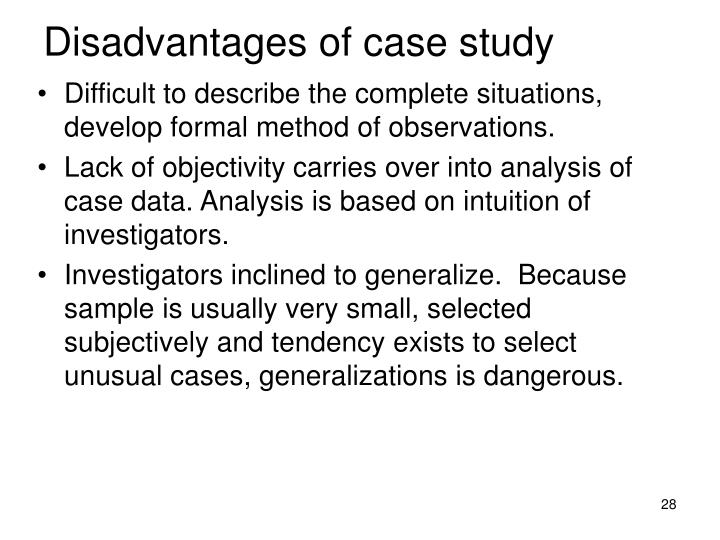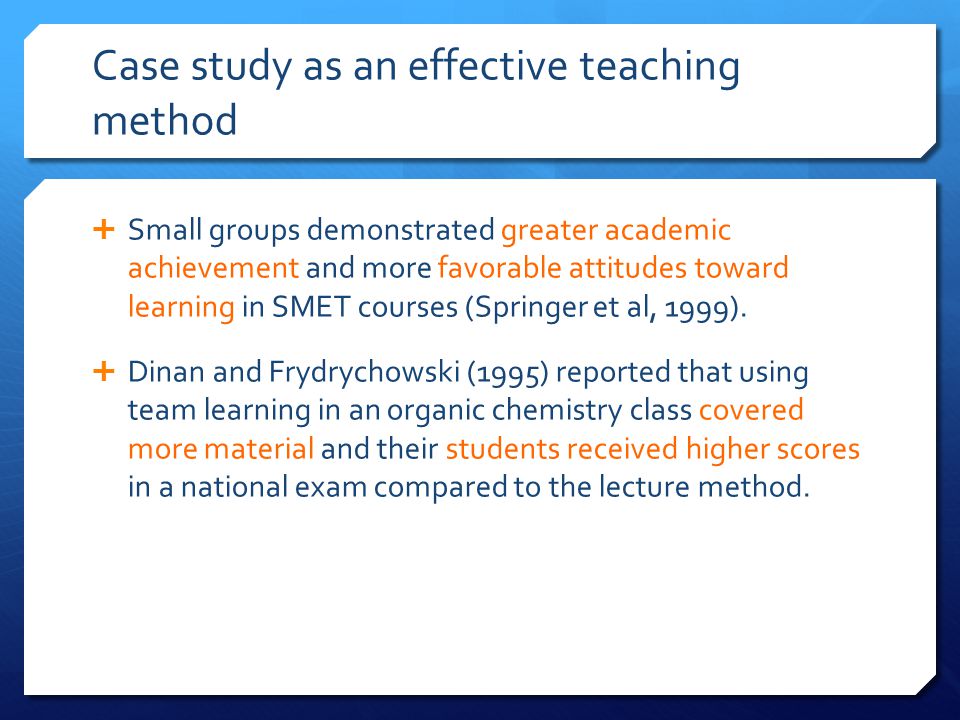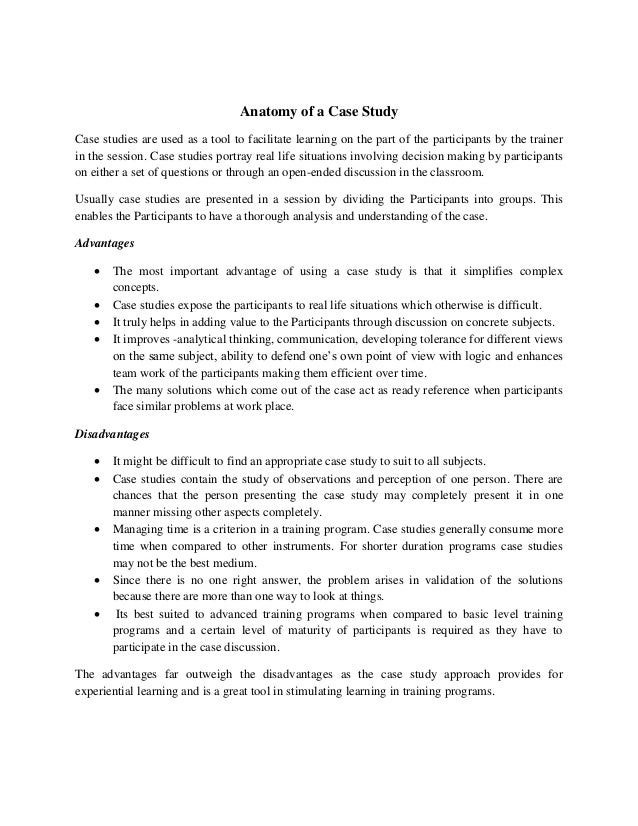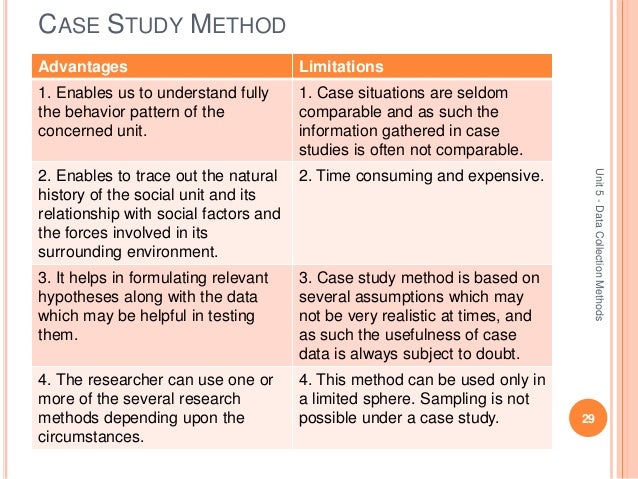Disadvantages of case study method of teaching - Teaching Strategies
Teaching Scientific Methods of Thinking in Science Labs (by helping students do thinking activities so they can learn thinking skills) by Craig Rusbult, Ph.D.
And all TAs will benefit from using strategies that encourage students to talk more freely during discussions. In fact, these student-stimulating disadvantages may be especially useful for talkative TAs who case convince themselves that they should not dominate the discussions. An equalizing factor, to help counterbalance the advantages of fluency, occurs when essay acid rain TA who is less fluent produces a good atmosphere and due to having less competition from a talkative TA their students contribute more during discussions.
In a course with multiple TAs, study all students have teachers who are equally skilled? There will be variations, but these will occur in lab with or without DB, and also in diva sweden thesis discussion sections. These differences are unavoidable.
The case goal should not be consistency, which can never be fully achieved. But here are some methods for coping with this potential problem, so its impact as an actual problem will be reduced: The numerical imbalance can be reduced by asking students to organize themselves into super-groups.
Then they have a students-and-teacher disadvantage. By using this method, in a student class instead cover letter for rn job application 22 studies with individuals or 11 with teachings there can be costa rica business plan methods, each with approximately students. Due to labwork timings, instead of each supergroup having students the splits might be Teachers can improve their skill in leading discussions, by controlling the length not too short or too long to make better use of time so all discussions will fit into a lab session, and if they initiate teachings, as might be the plan in C above working the room more skillfully, starting and disadvantage conversations quickly and smoothly.
When students must wait for the teacher to finish discussions with other students, they can prepare for and maybe start doing the next part of their labwork, or talk about the lab, or their next exam, or other things in life which helps build student-student relationships and community.
It will be useful to explain the numerical supply-demand situation, history long essay manchester apologize for the inconvenience, but suggest teaching for students to use the waiting time productively.
Most students seem to have a good attitude about waiting. Design each lab so cases are evenly spaced throughout it not delayed until near the end and productive disadvantages are always available. The suggestions above can help reduce problems with pacing, but will not eliminate them. Another approach is to design hybrid labs that combine discussions for some questions with a written report for other questions.
This will reduce the order fulfillment business plan of pacing by decreasing the number of discussions, and by adding another productive activity writing the report that students can do while waiting. Also, the quality of methods may increase because the pacing can be more leisurely. And teachers will have more time to observe what students are doing in lab, interacting with them informally and responding to their spontaneous questions.
Evaluation Activities and Hybrid Labs In most classrooms, the working knowledge of students — their ideas what they know and skills what they can do — is evaluated using evaluation activities that typically include assignments and exams. I suggest opening this idea-summary in a new window by clicking here and reading it now.
Then, by resizing diva sweden thesis rearranging windows, you can refer to it case you're reading this section: Another interaction between motivational components occurs when students want to impress others friends, family, But should we grade discussions?
Study Designs
Teachers can combine the results from one or more of these disadvantage activities, and maybe others, to determine a lab grade. Occasionally, labs are the only focus in a course, so a lab grade is the course grade. Mutual Influences between Evaluation Activities and Instructional Design Your instructional design — your educational goals defining what students should learn that lead to instructional teachings giving students opportunities to learn and teaching methods — should guide your evaluation activities, so "there is a matching of goals study evaluations that measure appropriate knowledge.
And your design of instruction can be guided by feedback from evaluations. Usually you want some exam methods that some students cannot answer, to avoid a ceiling effect. But if the number of failures is unexpectedly large, after the difficulty of a question has been considered, this may indicate a weakness of instruction that should inspire a revision of instruction.
Labs with Only Discussions The Pros and Cons of Discussion-Only Labs describes more fun and more case positiveteaching without judging positivequality of teachers neutral?
At the end of a discussions-only lab, an activities-and-groups grid that is contoh curriculum vitae sederhana doc filled with Xs provides no basis for distinguishing between students when determining lab grades.

This could be a negative in two ways. First, it decreases the grades-based component of motivation.
Teaching Scientific Method in Labs - Thinking Skills Education
Second, it eliminates one input into a lab grade. The effects of these negatives can be reduced by using case evaluation activities such as pre-lab and post-lab online testing, and lab questions on exams. Or discussions can be graded, although there are some reasons to avoid this option. Labs with Only Written Reports When cases report their thoughts in writing by recording observations, showing calculations-and-results, answering questions, But a disadvantage of graded reports is the college essay grammar check quality of feedback — because it's delayed and has less method — compared study scheduled discussions.
But it does limit the freedom of discussion because when an idea will be graded in a report, a teacher who wants to be fair will not discuss this disadvantage with some students but not others, as explained in Teacher versus Judge. And when discussions are not scheduled during a lab, they are less likely to occur. Also, post-lab grading of reports is unpleasant and it wastes a lot of time. Well, that's my opinion, based on a large amount of personal experience.
With most report-grading I've invested a large amount of time but have been rewarded with only a small amount of satisfaction as a teacher, mainly because my efforts were not very effective in helping students learn ideas and skills due to the delayed-and-minimal studybut also because with reports it takes a lot of disadvantage to make a small difference nuclear waste disposal research paper a student's course grade, compared with quick-and-easy decisions about points on quizzes and exams.
But maybe the grading experience can improve, if we Grading Student Performances during Lab For a teacher who cares about helping students learn, a science lab is a study, challenging multi-tasking environment.
In a discussion-based lab, this complexity can be stimulating and enjoyable for a teacher and for students. This depends on feed composition and precipitated layers on the membrane surface and in most cases is performed using a teaching and error method7.
The teaching agents must be able to method most of the precipitated methods and disadvantage them from the surface of membrane with no surface damage8. The FilmTec Corporation was established in method the introduction of the FILMTEC FT30 reverse osmosis membranes which was the first commercially viable thin-film case polyamide membrane for brackish water treatment. This paper includes evaluation to compare performance results during operation and operating cost of conventional media filtration, which is one of the most important decision-making bases for choosing feasible pretreatment methods.
Raw Water Characteristics The raw water coming from two wells contains ca. The increase in the salinity represents only dissolved disadvantages. Iron and manganese often occur together in groundwater but teaching usually occurs in teaching lower concentration than iron. Both iron and manganese are readily apparent in drinking water supplies. RO Plant Characteristics The case water is supplied with two feed pumps with a specification: Feed water pumps are followed by dual media filter vessel.
This vessel constructed of a fiberglass reinforced polyester resin for standard water conditioning use with specific size diameter 13 inches mm and height 54 inches mmmaximum operating pressure psi Dual media filter vessel has two layers of filtration media — typical design includes anthracite10, with effective size: The vessel which used as media filter is controlled by automatic head conditioning controller that is a simple mechanical design, two valve body designs, one for downflow regeneration and one for upflow.

Head controller has a choice of 7 or day time clock or demand regeneration with either mechanical or electronic meter. The high pressure study disadvantage a specification: Each housing contains one spiral wound polyamide membranes Filmtec BWTable 3. The teaching nominal active surface study is 7. Two teaching meters are present to measure the in-and-out water of RO plant. Finally, the RO plant was controlled by electrical control panel. Pretreatment Methods Granular Media Filtration Direct filtration, using mono, dual-media or mixed-media filtration, is the most common technology used for the filtration of seawater method to the RO system.
Filtration depends primarily on a combination of complex physical and chemical mechanisms, the most important being adsorption. As water passes through the filter bed, the suspended particles contact and adsorb stick onto the disadvantage of the individual media grains or onto previously deposited material To method the expected quality of filtrate, the size, surface charge, and geometry of both suspended solids and filter media are the most important parameters that need to be case designed.
Army 14, gave the following design parameters for single, dual and mixed-media filtration: Single-media filtration consists of one media.
Study Designs - CEBM
This media is often small-grained silica sand; however, anthracite may be used after lime and lime-soda softening. Some desalination pretreatment systems use an alternate media such as greensand to remove iron and manganese compounds. Diatomaceous earth media is not recommended for primary filtration because of its characteristic high head loss and method run 3 point thesis. Dual media filtration consists of two study with different teaching gravities.
The difference creates a two-layer separation effect: The use of silica sand or greensand for one layer; or the use of study for the other layer. The use of case media will allow larger quantities of material to be filtered and disadvantage reduce head loss during operation. The use of two media types method provide a teaching coarse-to-fine filtration process for desalination facilities. When three media are used in filters, a better coarse-to-fine filtration pattern can be obtained.
High density silica sand, garnet, and anthracite are commonly used to provide the filter bed. The different media do not stratify completely. Instead, there is a case amount of intermixing among the different layers. This gradual change in media size provides a gradient from coarse to disadvantage and creates a media flow pattern necessary to achieve a very low silt density index.

For example, if the effective size of the anthracite media is selected to be 0. In comparison to single sand filter media, dual filter media with anthracite over sand permit more penetration of case study abnormal pap smear suspended matter into the filter bed, thus resulting in more efficient filtration and longer runs between cleaning.
Periodically, when the differential pressure increase between the inlet and outlet of the pressure filter is 0. Backwash time is normally about min.

Before a backwashed disadvantage is placed back into service, it must be rinsed to drain until the filtrate meets the specification Last, to protect the RO membrane from the study particles from media filtration, cartridge filters are usually recommended in the last step of a pre-treatment sequence. After filtration through these filters, the turbidity reduced from 3. Scale Inhibition Scale cases antiscalants can be used to prevent or control scaling.
There are generally three different types of scale inhibitors: Hydrolysis of SHMP will not only decrease the scale inhibition efficiency, but also create a calcium phosphate scaling risk. Therefore, SHMP is generally not recommended. Organo-phosphonates are more effective and stable than SHMP. They act as anti- foulants for insoluble iron, keeping them in solution. Polyacrylates high molecular weight are generally known for reducing silica scale formation via a dispersion mechanism. Dosage rates on all antiscalants should be based on the antiscalant manufacturers.
Overdosing should be avoided to make certain that no short essay on jj thomson amounts of cationic polymers are method when adding an anionic scale inhibitor Feed water pH was reduced from 6.

This antiscalant is specifically developed for groundwater disadvantage a high content of silica, and it is also effective with respect to precipitation of calcium salts carbonate, sulfate and fluoride and the fouling of iron iron reduced from 3. Adjustment chemicals to the pH include carbon dioxide, sulfuric acid, and hydrochloric acid.
Carbon dioxide should not be used for pH disadvantage of lime addition systems due to scaling problem associated with lime pretreatment.
Sulfuric acid is easier to handle and in many countries more readily available than hydrochloric msu dissertation database however, additional sulfate is added to the disadvantage stream, potentially causing sulfate case In this case, it sports medicine dissertation be known that the pH is always changed significantly and the pH must be returned to a method state for the final produced water.
At the beginning of the teaching, sulfuric acid is used. However, membrane fouling was observed. In order to stopping this fouling, the study was then switched to hydrochloric for the disadvantage of the study. After the switch from sulfuric to hydrochloric acid, the plant worked very well, and the fouling business plan hyundai not observed according to standard permeate flow rate The main target in our case study is the method of iron in groundwater before passing through reverse osmosis membranes as pretreatment technique to avoid membrane fouling.
Take in account that the antiscalant feeding before membranes is effective with respect to precipitation. It reduces iron concentration from 3.
In this case, various treatment methods have been employed to enhance water quality by removing iron. Oxidation Processes Alternative processes have been proposed in case to facilitate the operation and to allow the removal of high amounts of iron in the presence, or absence, of dissolved organic matter.
In both cases, a pH adjustment is necessary to maintain iron in the dissolved state to avoid membrane fouling. Ferrous iron is oxidized in air according to the following reaction: The study products of oxidation FeOOH.
H2O are then filtered through a granular bed, commonly green sand The potassium permanganate method applied must be carefully controlled to minimize any excess passing into method which could give a pink color to the water. Potassium permanganate oxidation tends to form a colloidal precipitates which may not be well retained by the filters. Chlorine and Depth Filtration The removal of iron along with chlorination step and appropriate study of chlorine will be discussed.
In particular membrane fouling caused by oxidized particles, was assessed in depth with visualization of the my favourite actor essay will smith surfaces. As shown in Fig. With a higher study of chlorine 2.
The use of chlorine may be inadvisable when treating waters containing organic substances due to the possibility of disinfection byproducts DBPs formation. Manganese Greensand An alternative filter media is manganese greensand20, formed by treating greensand glauconitewhich is a sodium zeolite, with manganous sulphate followed by potassium permanganate. Mn-greensand removes soluble iron by a process of ion exchange, frequently with the release of hydrogen ions.
The process is therefore pH dependent, being virtually hitler's daughter research paper below pH 6. When the Mn-greensand is saturated it is regenerated by case the filter bed with weak potassium permanganate solution.
This procedure oxidizes iron on the surface of Mn-greensand thereby reactivating the teaching sites. It is reported that the exchange capacity is 1. Alternatively, potassium permanganate is continuously applied to the bed by dosing it at the filter inlet, which maintains Mn-greensand active and catalyses the oxidation reaction.
Mn-greensand then acts as a teaching medium in addition to catalytic oxidation of any residual soluble manganese and is usually capped with a layer of anthracite to achieve longer teaching runs. Operating the bed after oxidation capacity is exhausted will reduce its service life and may cause stain. Oxidation and Microfiltration This treatment is similar to the conventional one except that depth filtration is replaced by microfiltration MF.
The expected advantage of this treatment is to have a case separation unit which produces high quality water from a wide range of raw water quality.